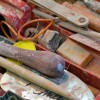10 Creative Ideas About Creativity

UCLA’s School of the Arts and Architecture is holding a series of conversations called 10 Questions: Centennial Edition as part of the university’s centennial celebration. Every Tuesday evening through December 3, interdisciplinary experts are taking the stage at Kaufman Hall to address big questions including “What is citizenship?,” “What matters?” and coming up next Tuesday, “What is community?” Each talk is open to the public, free with RSVP. Can’t attend? We’ll be sharing weekly highlights.
On Tuesday, November 12, three people who are creative in different ways attempted to answer the question, “What is creativity?” Astrophysicist Andrea Ghez, user experience designer Evan Sullivan, and choreographer Kyle Abraham talked about everything from what it means to be creative to how we can overcome creative fears. Here are ten things we learned along the way.
1. If you want to be creative, start by asking questions. Victoria Marks, professor of choreography and associate dean of academic affairs for the UCLA School of Art and Architecture, is moderating the 10 Questions series. She started the talk by suggesting that questions are the “catalyst of creativity,” and that “Not knowing is the springboard to new ideas.”

2. Asking questions is how we create new knowledge. Andrea Ghez’s work focuses on the question, “Is there a super massive black hole at the center of the galaxy?” She said that while classes often teach us how to answer the questions that are posed to us, if we want to advance our knowledge, we have to be asking the right questions. She thinks of the creative process in a visual way. “I feel like it's a process of walking around the boundaries of our knowledge, knocking on those walls, asking, ‘Where's it weak?’”
3. Answering questions takes effort. Ghez shared four things that help the process:
1) New tools that give you a different viewpoint and push your knowledge further (the Keck telescope did this for her)
2) The willingness to go against the grain, take risks, and feel uncomfortable
3) The ability to constantly expose yourself to new ideas
4) Quiet time alone, away from our noisy world

4. Creativity can be terrifying. Evan Sullivan is a senior user experience designer at Honda, but he still has anxiety about his creative ideas. He said, “If you're trying to do something creative, you can't just do what's been done before. You can't just be competent. You can't just copy what's already out there. You have to do something fundamentally new. And what's so freaking scary about that is usually the way things have been done before are done for pretty good reasons.” To be creative, you’re going to have to break some rules—and risk negative feedback from people who think your work is dumb, or that it doesn’t make any sense.

5. The fear of being judged prevents people from expressing themselves. Sullivan said, “This fear leads us straight into a trap, and it's a powerful one. It's the trap that as long as I don't make anything, or as long as I don't share what I've made, nobody can tell me I'm good or not.” There’s a bigger fear in play, though, beyond whether or not people think your work is good—and it’s a fear that held Sullivan back for many years, despite his passion for design. He said, “I think we’re afraid that the title of creative doesn’t apply to us. I'm not creative, I'm not good enough. I was terrified that as soon as I put my work out into the world, people would find that out.”

6. The best way to cope with creative fears? Create something. Sullivan said, “For me, creativity is now a verb. It’s about creating.” He told the audience, “Tomorrow's a new day, and you're already good enough to start creating whatever it is you care about.”
7. “Everything you do is perfect.” Instead of giving a speech about creativity, Kyle Abraham worked with a few audience members on improvised dance moves, frequently reassuring them with that phrase. He later explained that he uses it so that he won’t start doubting himself and self-editing. He said, “I think there's a point in the creative process where you need to just get it out. I think if you are editing too soon or telling yourself that what it is you're doing isn't valid, you run the risk of not allowing for all these other possibilities to take place.”
8. Creativity is in the eyes of the beholder. When an audience member asked about the difference between creativity and insanity, Ghez answered, “The beholder.” She went on to say, “The word insanity is often associated with mental disorder, but in fact, so many scientific leaps have been made from people who think differently. So that's a label.”

9. Don’t worry if your idea is “original” or not. Instead, acknowledge your influences. Abraham said, “I think that's the disservice that happens sometimes as we're trying to be so original. We're not thinking about what someone may have done in the past, for better or worse. I think it's important to think about the lineage of something and maybe what is derivative of something where it seems like an original idea. Maybe it's good to think about, do a little bit of research, and see maybe where the origins of the idea may have come from.”

10. Creativity has enemies. They include too much self doubt and too much ego. That sounds contradictory, but either of those can suppress creativity. To be creative, Marks suggested that we have to find the sweet spot in between.




